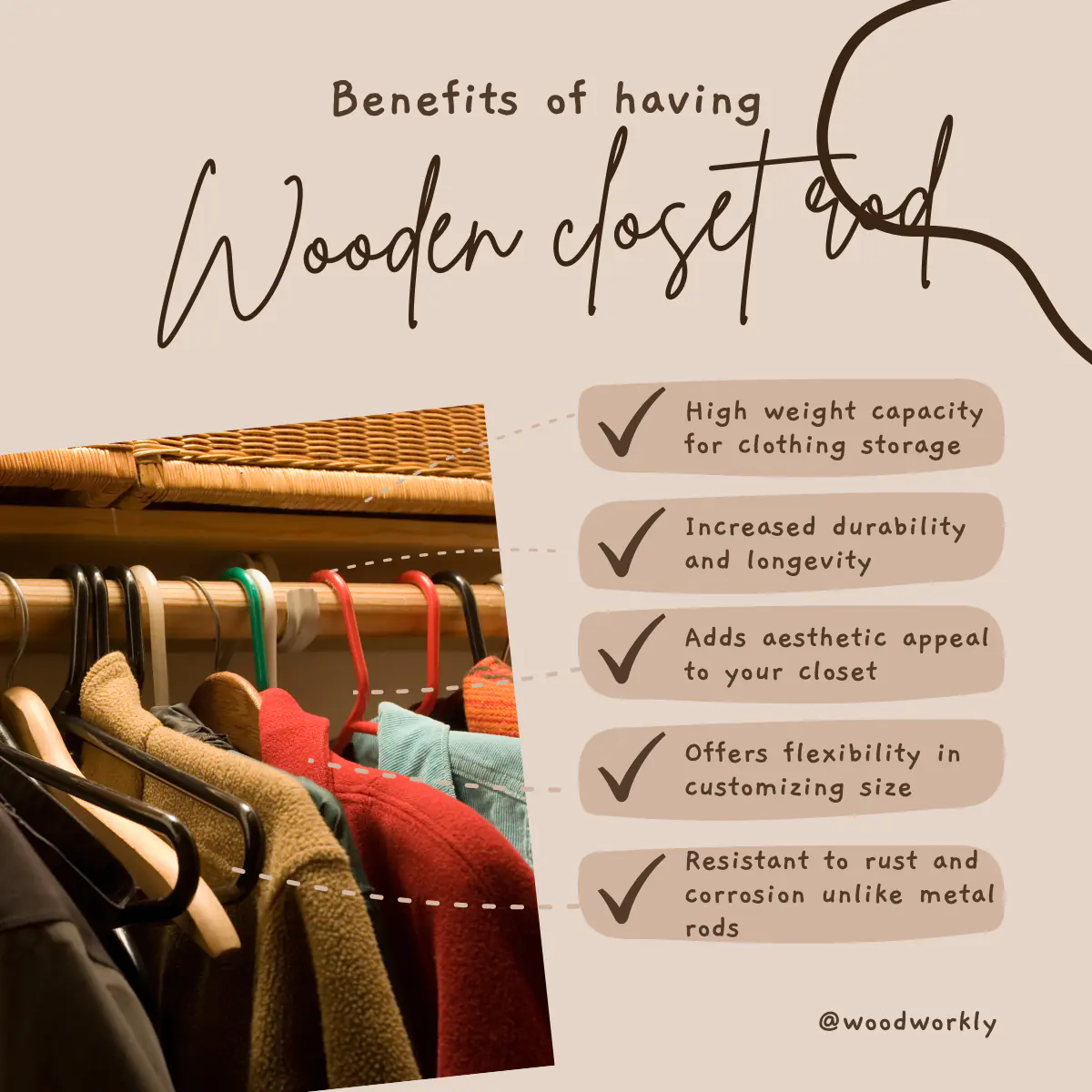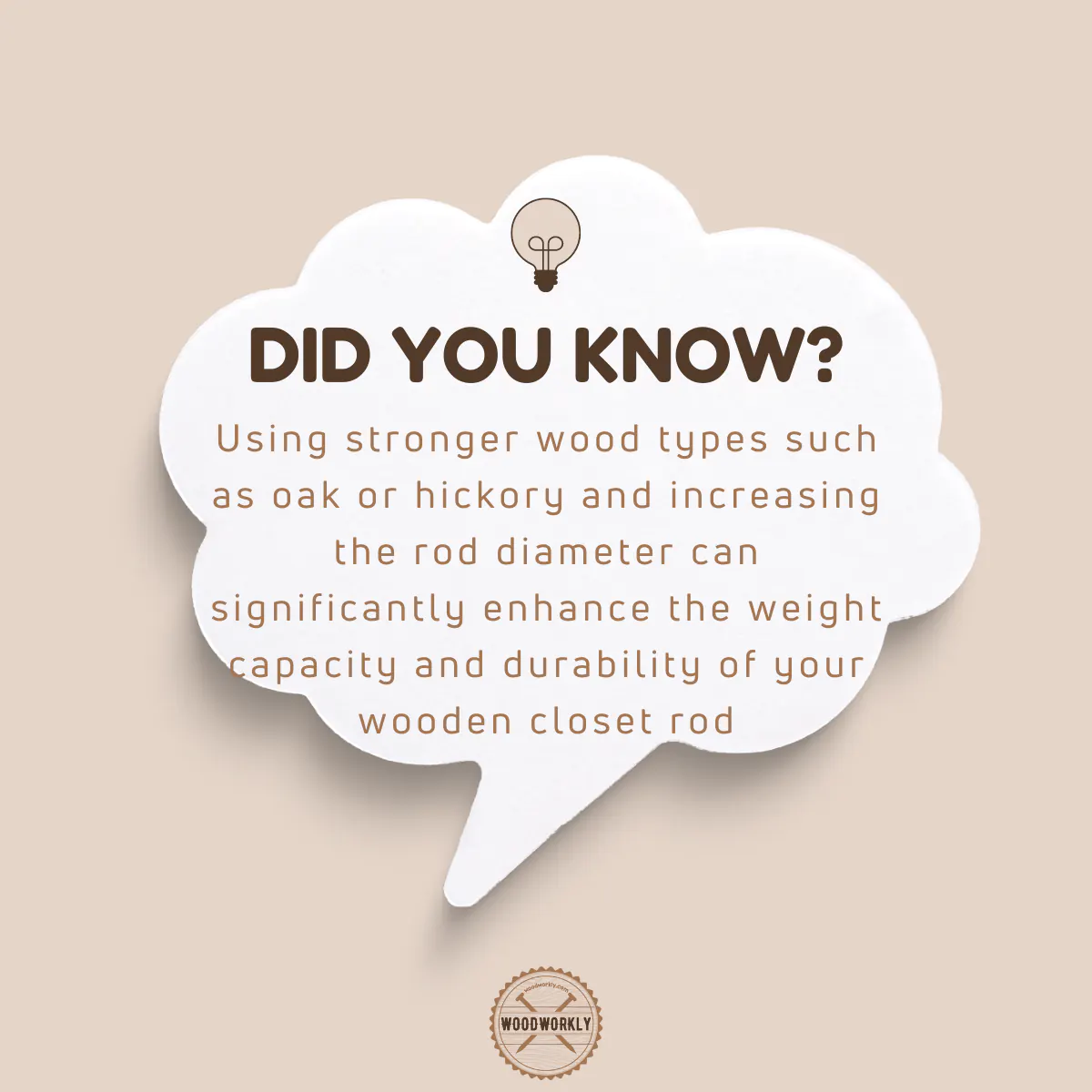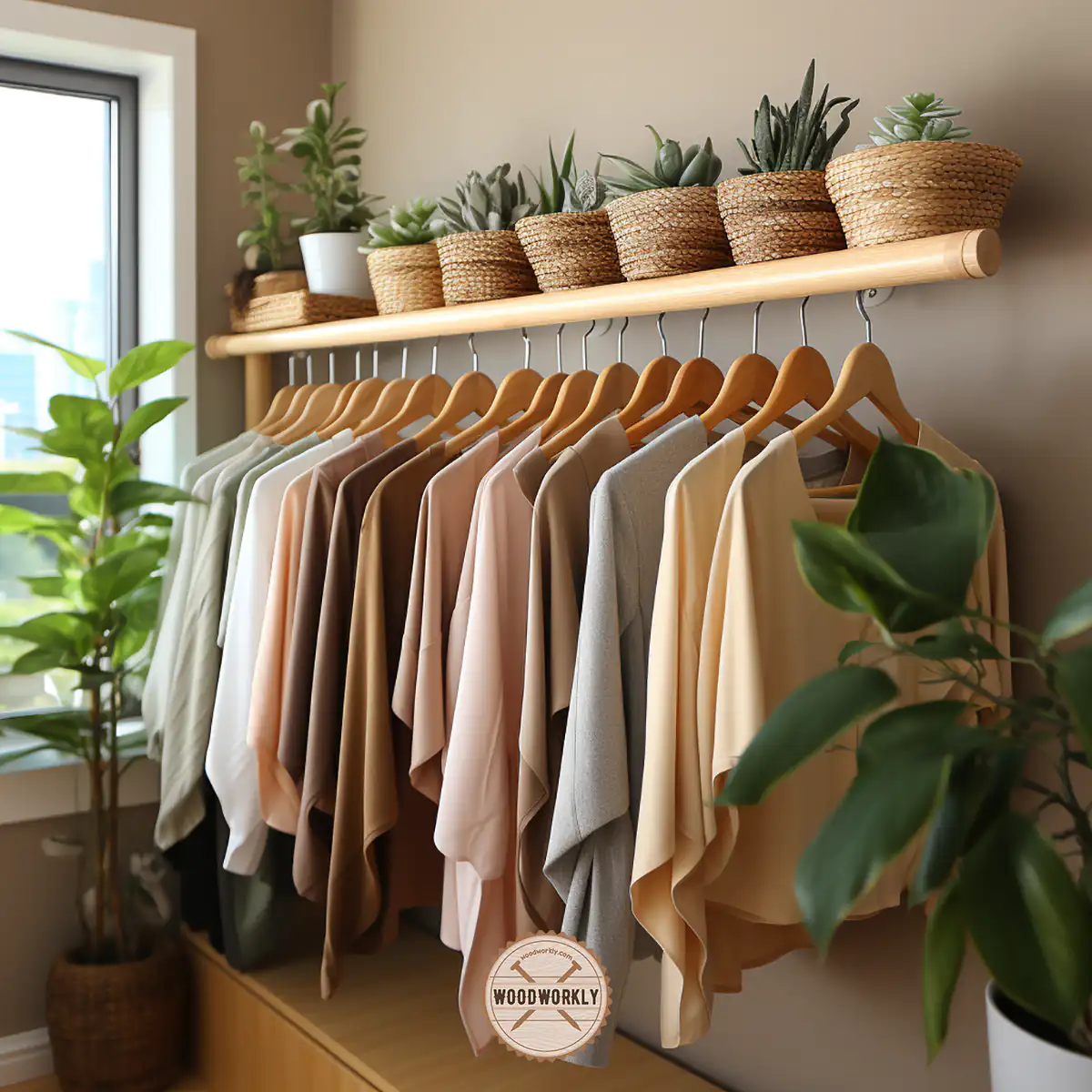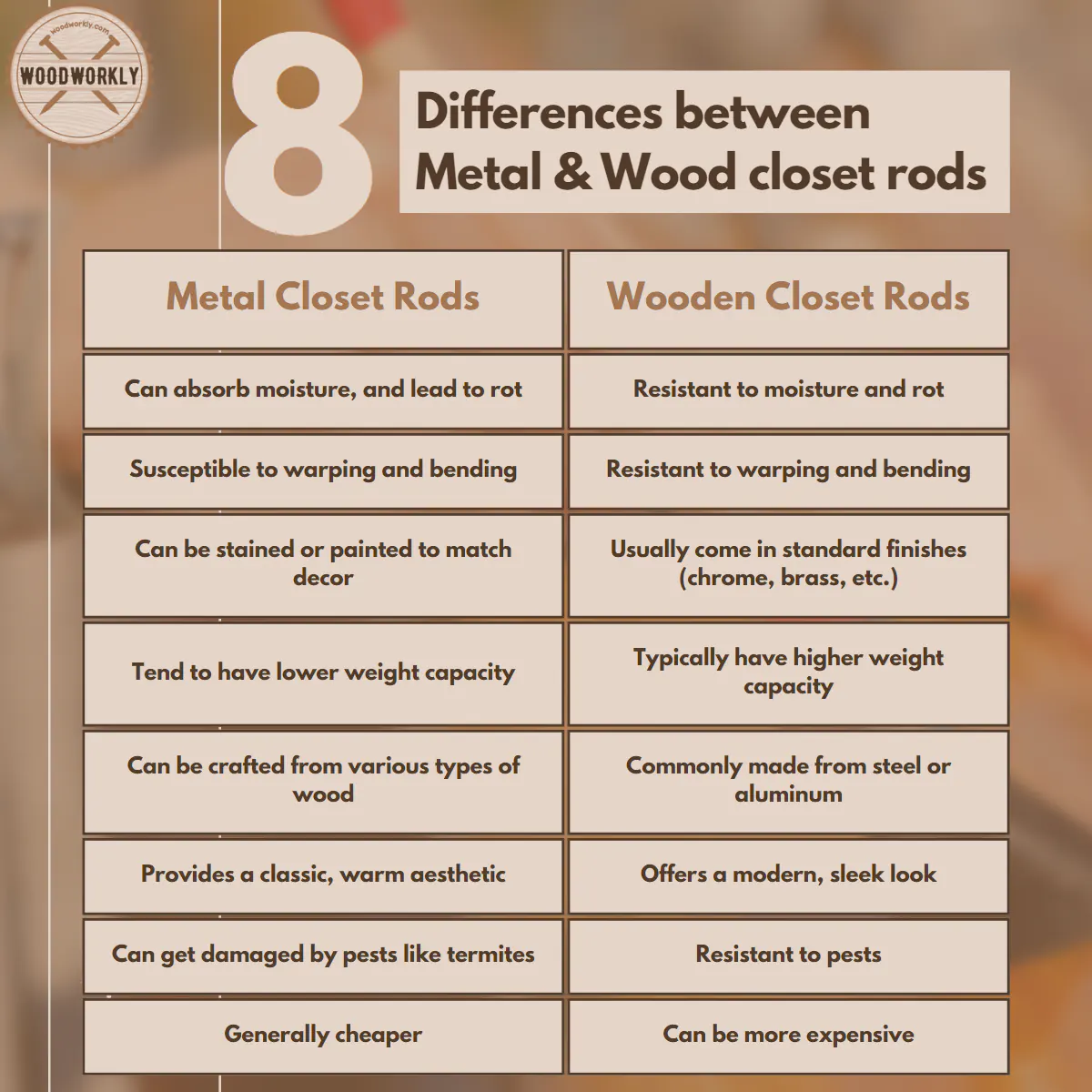Ever faced a closet calamity with overloaded rods? Have you wondered, “Just how much weight can a wooden closet rod hold?” Let’s unravel this mystery together.

Closets are used as storage areas for hanging clothes, handbags, belts, and many more items.
Most closets are primarily made of wood, including closet rods, which can be made from both wood and metal.
In an eco-friendly approach, many people tend to use closet rods made from various types of wood.
However, I’ve often wondered about their strength and did an experiment by taking different sizes of closet rods from different wood types.
So, Let’s find out, how much weight can a wood closet rod hold?
A wooden closet rod can hold up to 100 pounds. The weight capacity of the closet rod depends on the wood type, the rod’s thickness, and its length. Stronger wood types like oak or specially made rods can support even more weight, up to 500 pounds.
But that’s just a quick snapshot of the question.

As a woodworker, you need to consider the quality of the lumber since it is a decisive factor to decide how much weight can a wood closet rod hold.
In this article, I’ll explore a little deeper how long can a wood closet rob be without and with support, how to support a wood closet rod, and will compare wood closet rods with metal closet rods as well.
Furthermore, I’ll answer some frequently asked questions as well.
Just keep reading!

First of all, I’m going to share with you a brief knowledge about wooden closet rods.
What Is A Wooden Closet Rod?
A wooden closet rod, also referred to as a closet pole or closet rod dowel, is an integral part of your wardrobe organization.
It’s a simple device that goes a long way in making our lives a lot easier.
Let’s dive a little deeper and get acquainted with this unsung hero of your closet.
The Basics of a Closet Rod
In the most basic sense, a closet rod is a cylindrical pole made of wood that’s installed horizontally within your wardrobe or closet.
Wooden closet rods’ primary purpose is to provide a place to hang your clothes on hangers.
The concept of a closet rod is nothing new, but the materials, designs, and strengths have evolved over time to fit our changing needs.
Types of Wood Used in Closet Rods
Closet rods are available in various materials, including wood, plastic, and metal.
Among these, wooden closet rods are highly popular for their blend of functionality, durability, and aesthetic appeal.
Different types of woods are used to make these rods, each having its unique strengths and aesthetic qualities.
For example, hardwoods such as oak and hickory are known for their robustness and can support more weight per linear foot.
On the other hand, softwoods like pine can be lighter but might not hold up as much weight.
Beyond Just Hanging Clothes
A wooden closet rod isn’t just about function; it also contributes to the overall aesthetics of your wardrobe.
It gives your closet a classic, warm look that plastic or metal rods often can’t match.
Plus, with various finishes available, from varnishes to paints, you can tailor the look of your wooden rod to match the rest of your closet or room decor.

The Strength of Wooden Closet Rods
One question that often comes up when discussing wooden closet rods is their strength.
According to the experiments I did with various closed rods, the standard wooden closet rod can hold between 80 to 100 pounds, although some special rods can hold a lot more, up to 500 pounds or more.
It’s important to note that the weight capacity depends on several factors, including the type of wood used, the rod’s diameter, and the strength and installation of the support brackets.
How To Choose The Right Wooden Closet Rod?
When choosing a wooden closet rod, consider its intended use.
If you’re looking to hang heavier items like winter coats or numerous clothes, a sturdy hardwood rod might be a good choice.
However, for lighter items or if you’re more concerned about the aesthetics, a softer wood could be suitable.
Wooden Closet Rods: A Long-Lasting Choice
While some may argue that metal rods are stronger and more durable, it’s important to remember that with the right care and maintenance, a wooden closet rod can last for years.
And they can hold their own in terms of strength too. For example, bamboo, which is technically a grass but often considered a type of wood, has a higher tensile strength than steel.
As you can see, a wooden closet rod is more than just a pole to hang your clothes.
It’s a piece that blends function, strength, and aesthetics, making your closet organized and pleasing to the eye.
Whether you’re redesigning your closet or just looking to improve its functionality, remember to consider a wooden closet rod for its many benefits.
Standard Weight Capacity of a Wooden Closet Rod
The weight a wooden closet rod can bear typically depends on its material, diameter, length, and the quality of the supporting brackets.
However, as a general rule of thumb, a standard wooden closet rod can hold between 80 and 100 pounds.

Factors That Influence Weight Capacity of Closed Rod
There are several factors that influence the weight capacity of a wooden closet rod.
Let’s delve into them.
Type of Wood
First and foremost, the type of wood used in the rod significantly influences its strength.
Hardwoods like oak or hickory typically withstand more weight per linear foot without breaking, compared to softer woods like pine.
For instance, certain oak closet rods sold at home improvement stores are known to hold 500+ pounds!
The Supporting Brackets
The strength of the supporting brackets and their installation quality can make or break (literally!) the weight-holding capacity of your rod.
A sturdy wooden rod attached to a weak or poorly installed support bracket system is more likely to fail under pressure.
Length and Diameter of the Rod
Another crucial consideration is the length and diameter of your closet rod.
Long rods tend to encourage users to hang more clothes, increasing the risk of sagging and breaking.
To counter this, thicker rods are often recommended as they provide more strength and resistance to bending.
However, it’s important to note that the diameter can’t be increased indefinitely, as the size of hanger hooks and the practicality within the closet space limit it.
Heavy-Duty Wooden Closet Rods
If you’re seeking a more heavy-duty option, there are wooden closet rods in the market designed to hold a lot more weight.
For example, the Closet-Pro HD 72-inch hardwood closet rod made from solid oak wood can support up to a whopping 300 pounds.
Similarly, the ZAQY multi-colored wooden closet rod can support up to 200 pounds.

How Long Can a Wood Closet Rod Be Without Support?
A wood closet rod can long for a maximum of 48 inches (4 feet) without support. If the wood closet rod is longer than 48 inches, it requires support.
The maximum length of the wood closet rod depends on,
- Wood type
- Weight distribution
- Quality of the wood
- Wood strength
- Wood diameter
If you hang lightweight clothes and other items, the maximum length of the wood closet rod can be much longer than 48 inches.
But if you hang heavy clothes, handbags, and belts and they’re distributed unevenly, you’ll probably need support for the wood closet rod.
The maximum length of the wood closet rod is 96 inches. Some manufacturers recommend using supports if the wood closet rod is longer than 32 inches.
So, better to apply supports once the wood closet rod surpasses 32 inches mark.

How To Support Wood Closet Rod?
There’re several ways you can support wood closet rods to bear more loads without any sagging.
Here’re the best methods to support your wooden closed rod,
- Recognize the closet
- Insert dowels to support the closet rod
- Make a solid hollow rod
- Add brackets
- Add prop
So, let’s discuss each of the above methods to get a clear idea about how to support wood closet rods.
1. Reorganizing the Closet
Dispose of Unnecessary Clothes
One way to support your closet rod is to reduce the weight it needs to hold.
Start by decluttering your closet and getting rid of clothes you no longer wear.
You might find it hard to part with some pieces due to sentimental attachment, but it’s a necessary step to maintain the integrity of your closet rod.
Consider donating them to a charity or giving them to friends and family.
Distribute Weight Evenly
When reorganizing, ensure the weight is distributed evenly across the rod.
Hanging all the heavy items in one spot can lead to sagging or even breaking at that point.
Spread out the heavy winter coats, suits, and other weighty items across the rod to ensure an even distribution of weight.
2. Insert Dowels
By inserting dowels into the wood closet rod, the maximum weight that can hold by the wood closet rod will increase.
Plus, you’ll be able to use wood closet rods that are longer than 48 inches as well.
To insert the dowel, drill holes that are ¼” in diameter near the top of the wood closet rod and insert ¼” diameter dowels into the hollow area.
Read to know the method of drilling holes in wood without splintering the wood!

3. Make a Solid Hollow Rod
A hollow solid rod increases the maximum weight capacity of the wood closet rod by adding extra strength to the wood.
First of all, you need to measure the internal diameter of the wood closet rod and take a solid hollow rod with a slightly higher diameter than the diameter of the wood closet rod.
Then push and insert the wood closet rod into the solid hollow rod.
The length of the solid hollow rod should be the same as the wood closet rod.
This will twice increase the strength of the wood closet rod and it will get the ability to bear heavy items without sagging.
Tips:
- Solid hollow rod and wood closet rod need to be tightly fitted. Otherwise, when the load is applied it will tend to sag and crack the wood.
- Same way if the diameters of the hollow rod and wood closed are almost the same, the wood closet rod will struggle to go through the solid hollow rod.
4. Add Brackets
Another way of increasing the maximum weight capacity of the wood closet rod is by adding brackets.
Using robust and high-quality brackets to support your closet rod can significantly enhance its weight-holding capacity.
For instance, a stainless steel closet rod bracket can hold up to 400 pounds. Ensure that these brackets are securely attached to the wall studs for optimal support.
Add brackets to each end of the wood closet rod.
They will support the closet rod to withstand heavy weight without sagging.
If your closet rod is longer than 48 inches, it’s advisable to add additional support brackets.
Adding a bracket to the middle of the wood closet rod will provide additional strength to the wood rod.
When the number of brackets is increasing the maximum weight capacity of the wood closet rod will also eventually increase.
Make sure to add brackets firmly to the back wall of the closet or add a shelf with brackets that hang down.
5. Add a Prop
By adding a prop to the bottom area of the wood closet rod you can increase the strength of the wood.
Prop works the same as brackets by providing extra support to the wood rod.
A fully secured prop will never sag or crack under heavy load and when compared to brackets, a prop takes less space and doesn’t bend like brackets.
That’s how you can support the wood closet rod to bear more load without any sagging.
In conclusion, here’re the things you can use to support wood closet rods.

What Can You Use to Support Closet Rod?
- Solid hollow rod
- Brackets
- Prop
- Dowels
Best Wood for Wood Closet Rod
How much weight can a wood closet rod hold depends on the type of wood. if you pick weak woods, they won’t hold the load as you wish.
Here’s the list of the best woods for wood closet rods,
- Cherry wood
- MDF
- Plywood
- Particleboard
- Pine
- Oak
Above woods are strong, hard, and resistant to warping and sagging. Therefore, they make the best closet rods.
Pros and Cons of Using Wood Closet Rods
| Pros | Cons |
| Cost-effective | Poor strength |
| Eco friendly | Need supports |
| Safe to use | Poor durability |
| Nice classical appearance |

What Size Dowel For Closet Rod?
In general, the standard size for a closet rod dowel is between 1 ¼ inches and 1 ⅜ inches.
This size is typically strong enough to hold a decent amount of weight without sacrificing aesthetics or usability.
When the size of the wood closet rod is high it is resistant to sagging and warping.
Balancing Strength and Usability
While you may be tempted to opt for a larger dowel size for added strength, remember that your hangers need to fit onto the closet rod easily.
A rod that’s too thick might not accommodate standard hangers, making it less practical.
Thicker Dowels for Heavier Loads
If you have a particularly large wardrobe or if you intend to hang heavy items such as winter coats and suits, you might want to consider a thicker dowel.
However, don’t forget the points mentioned above about hanger fit and aesthetics.
Thicker dowels, while stronger, may feel more intrusive in your closet space.
The Importance of Wood Type
While dowel size matters, the type of wood used for the dowel plays a crucial role in its strength and durability.
For instance, hardwoods like oak or hickory are naturally stronger than softwoods like pine.
So, even if two dowels are of the same size, the one made of hardwood will generally be able to support more weight.
Choosing the right size dowel for a wooden closet rod involves a balance of strength, usability, and aesthetics.
While a dowel with a diameter of 1 ¼ to 1 ⅜ inches is standard, the exact size you’ll need depends on the weight of the items you plan to hang and the type of wood used for the dowel.

Wood vs Metal Closet Rod
Both wood and metal closet rods are excellent in their own ways.
Each material has its own set of advantages and disadvantages, and understanding these can help you make an informed choice that suits your needs and preferences.
So, let’s delve into the world of closet rods and compare wood and metal options.
Strength and Durability
Metal Closet Rods
At first glance, it might seem that metal rods are the clear winners in terms of strength.
Generally, they are indeed stronger and more durable than their wooden counterparts.
Materials such as steel and aluminum are commonly used for metal rods, and they can withstand significant weight without sagging.
For example, a stainless steel closet rod can hold around 400 pounds on average.
Wooden Closet Rods
However, don’t rule out wood just yet. The strength of a wooden rod can vary greatly depending on the type of wood used.
For instance, hardwoods like oak are very strong and can support considerable weight, with some specially made rods able to hold 500+ pounds.
Even bamboo, often underestimated, has excellent tensile strength and can hold up more weight than aluminum.
Condition and Age
A new wooden rod might actually be stronger than an older metal one, particularly if the metal rod has seen some wear and tear.
Wooden rods can weaken in damp conditions, while metal rods can corrode when exposed to certain chemicals.
However, a well-maintained metal rod is typically more durable and longer-lasting than a wooden one.
Aesthetics and Feel
Wooden rods can add a touch of natural charm and warmth to your closet.
They’re available in a variety of finishes and can be stained to match your closet’s overall design scheme.
On the other hand, metal rods provide a sleek, modern look and are usually available in different finishes such as chrome, brass, or brushed nickel.
Price
Price could be a deciding factor too.
Metal rods tend to be more expensive than wooden ones, although the exact price will depend on the quality and finish of the rod.
So, if budget is a significant factor for you, you might want to consider a wooden rod.
As you can see, both wood and metal closet rods have their pros and cons, and the best choice depends on your specific needs, budget, and personal style preference.
Congrats folks! Now you know exactly how much weight can a wood closet rod hold thanks to the experiment that I conducted with different types and sizes of closet rods.

So, let’s answer some frequently asked questions.
FAQs
Does the type of wood impact how much weight the closet rod can hold?
Yes, the type of wood can greatly affect the weight capacity of a closet rod. Hardwood rods such as oak or maple tend to be stronger and more durable, hence can hold more weight compared to softwood rods like pine.
How much weight can a wooden closet rod hold compared to a metal one?
Wooden closet rods, especially those made from strong hardwoods, can sometimes hold as much weight as metal rods, but the capacity varies based on the material quality, diameter, and length of the rod. Typically, a well-constructed wooden rod can support hundreds of pounds.
Can I increase the weight a wooden closet rod can hold?
Yes, by ensuring the rod is properly supported with sturdy brackets spaced no more than 48 inches apart, you can optimize the weight that a wooden closet rod can hold.
Is there a risk of a wooden closet rod sagging under heavy weight?
Like any material, wooden rods can sag under heavy weight if not properly supported or if they’re holding weight beyond their capacity. It’s essential to evenly distribute weight and regularly check for signs of sagging.
What happens if I exceed the weight limit of a wooden closet rod?
Exceeding the weight limit of a wooden closet rod can lead to sagging, cracking, or even breaking of the rod. It can also cause damage to the wall or closet structure where the rod is installed.
Can I hang heavy winter coats on a wooden closet rod?
Yes, a wooden closet rod can generally support the weight of heavy winter coats. However, it’s recommended to distribute the weight evenly across the rod and not cluster all heavy items in one spot.
What Do You Call The Rods In Closets?
The rods in closets are commonly referred to as closet rods or wardrobe rails. They are used for hanging clothes and other garments.
How much weight can a wardrobe rail hold?
The weight a wardrobe rail or closet rod can hold largely depends on its material, length, diameter, and the spacing of its supports. A standard wooden closet rod, for instance, can hold around 100 to 120 pounds when properly installed and the weight is evenly distributed.
Did I cover all you wanted to know about: How Much Weight Can a Wood Closet Rod Hold?
In this article, I have widely discussed How much weight can a wood closet rod hold with and without support.
Plus, I’ve talked about how to support a wood closet rod with all the tools you need to improve its strength.
A wooden closet rod can typically support around 80 to 100 pounds, depending on the rod’s thickness, type of wood, and the span length. However, for better support and to prevent sagging, it’s advisable to install additional brackets for every 3 to 4 feet of rod length.
Wood closet rods cannot hold heavy weight without any support.
So, I always recommend you use support when using wood rods to prevent sagging and warping.
Because once the rod is sagged or warped, it is so difficult to regain its original shape.
Furthermore, I’ve answered some frequently asked questions as well.
Hope you have gained pretty good knowledge about, how much weight can a wood closet rod hold and how can you improve its strength by using woodworking techniques.
Keep strengthening your closet rod to make it more durable and steady!